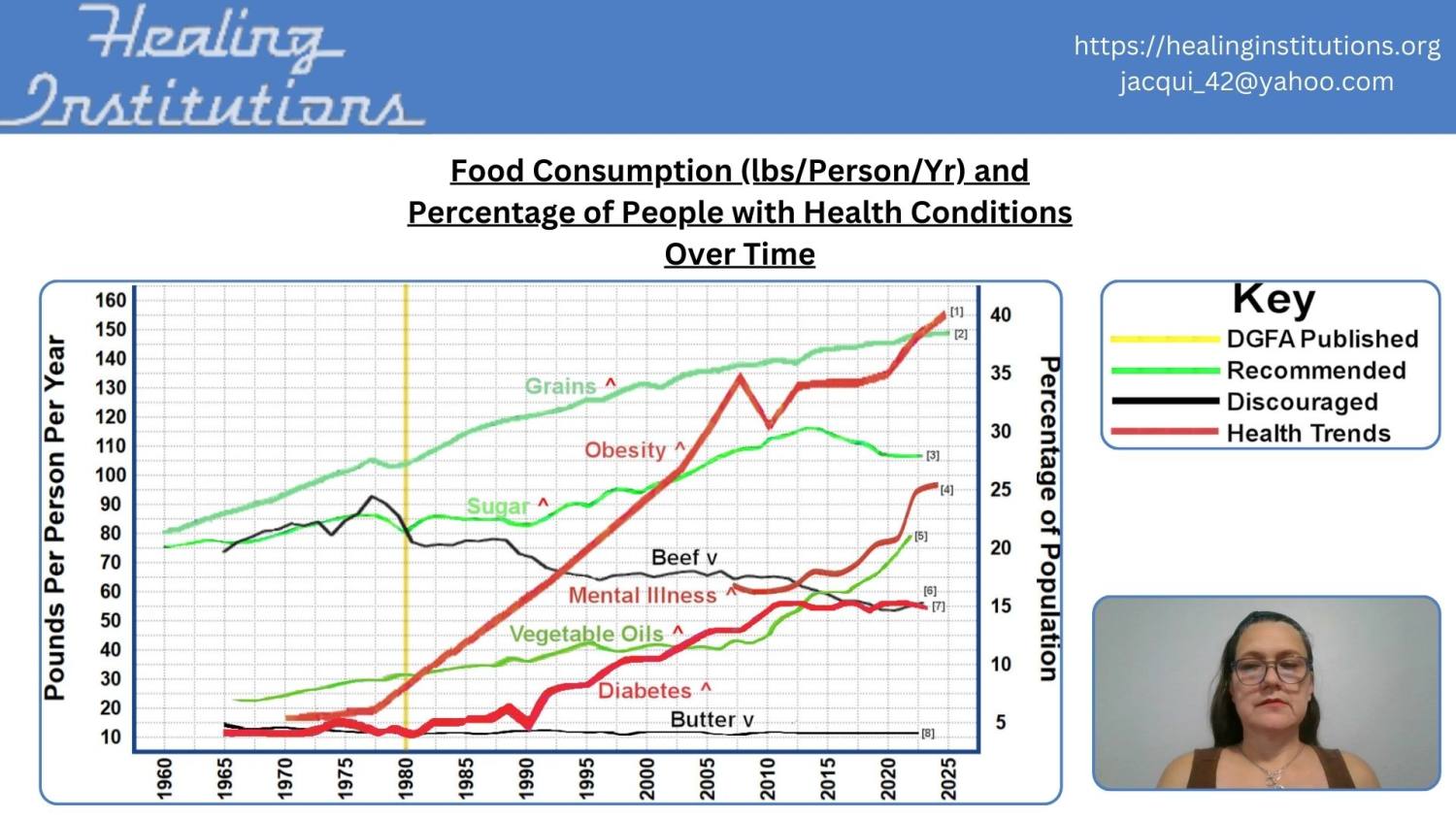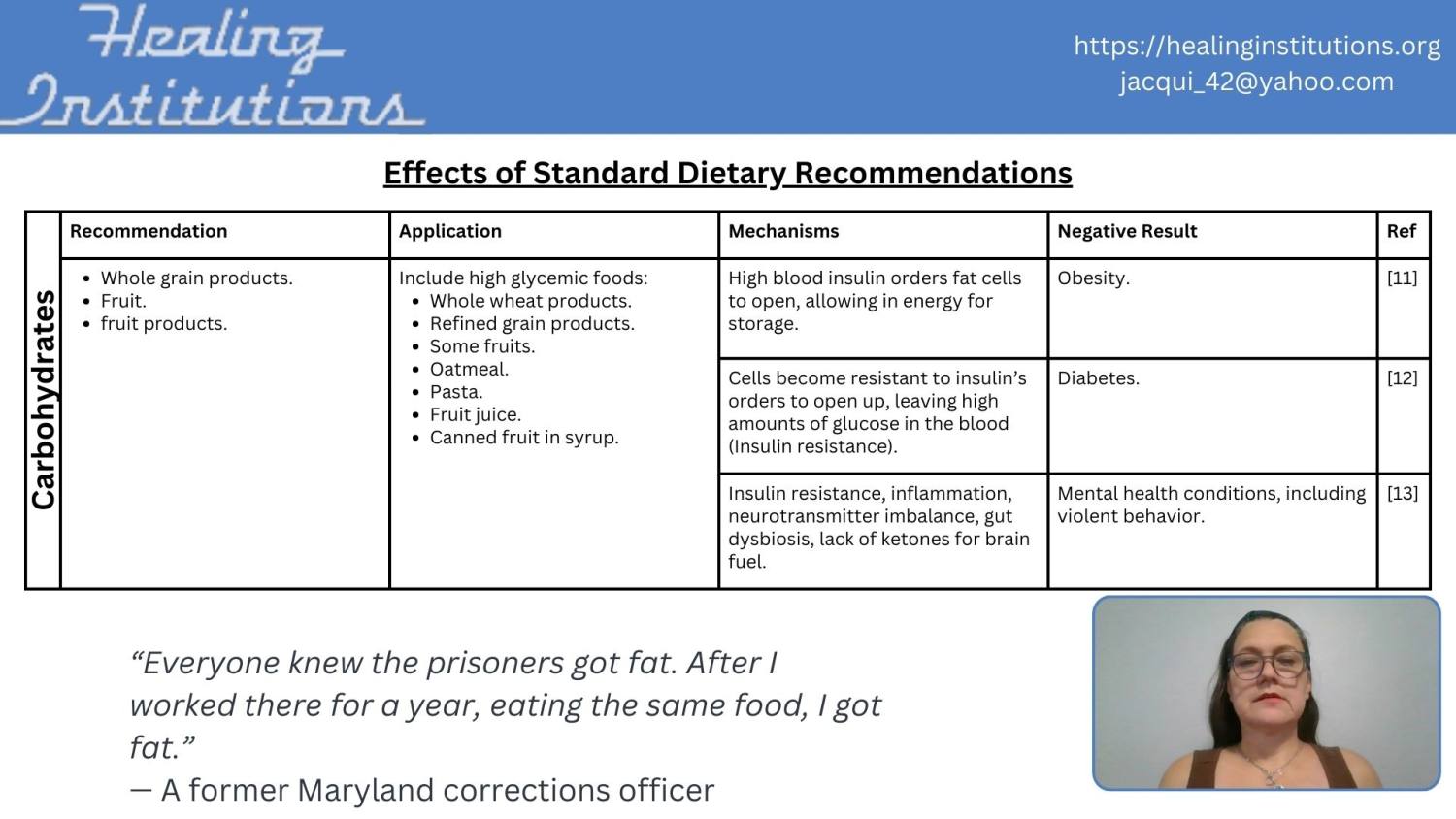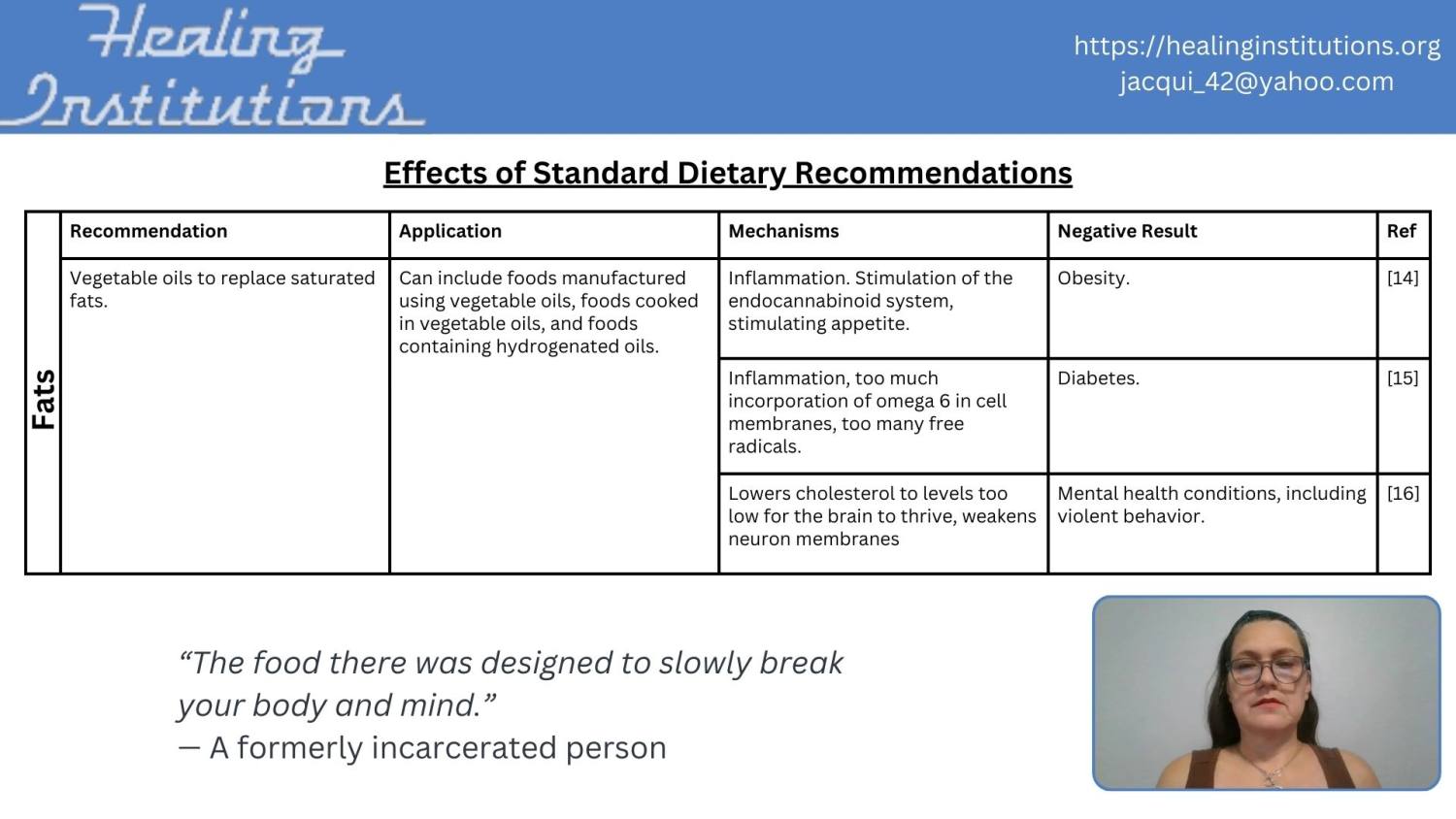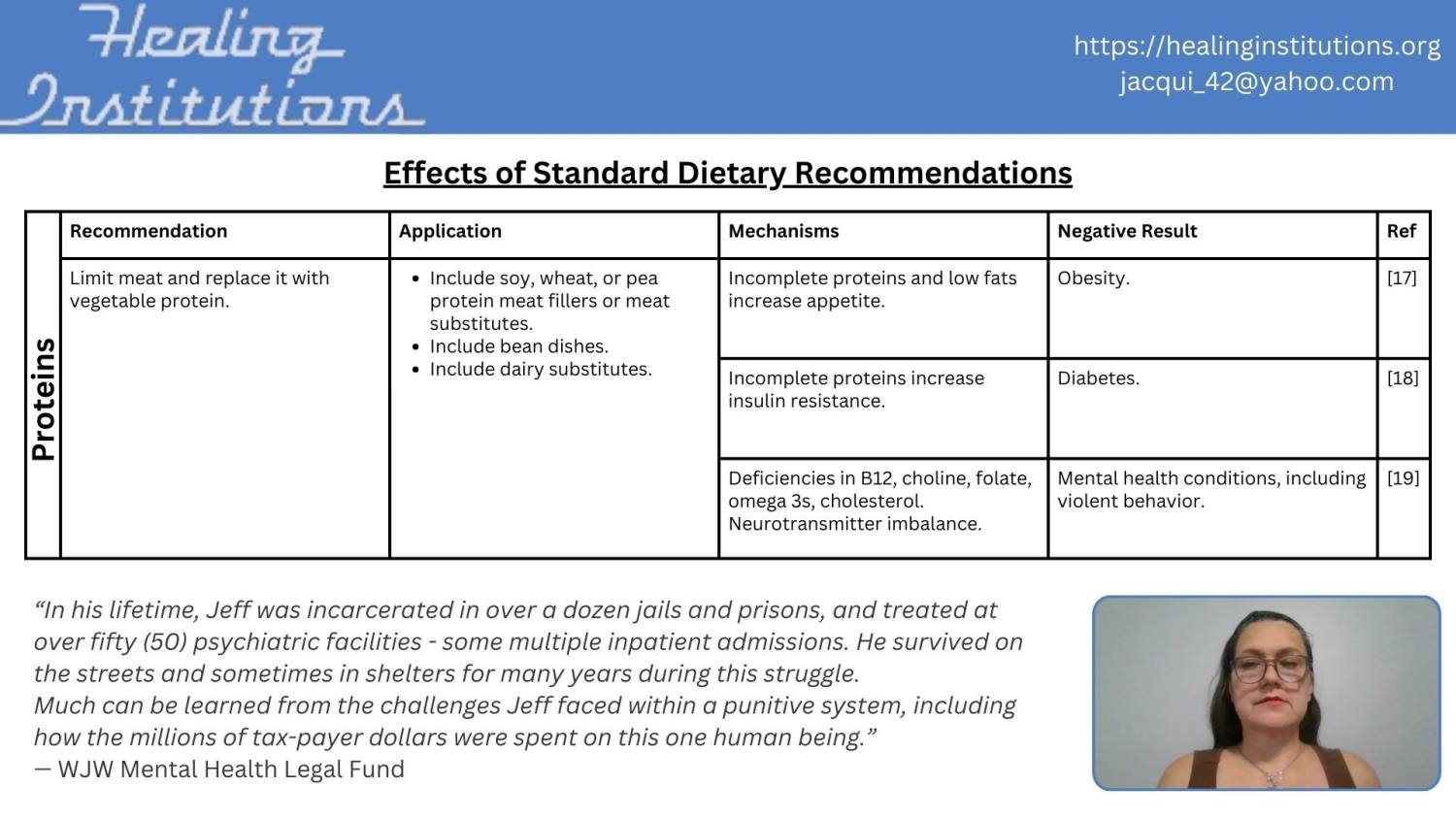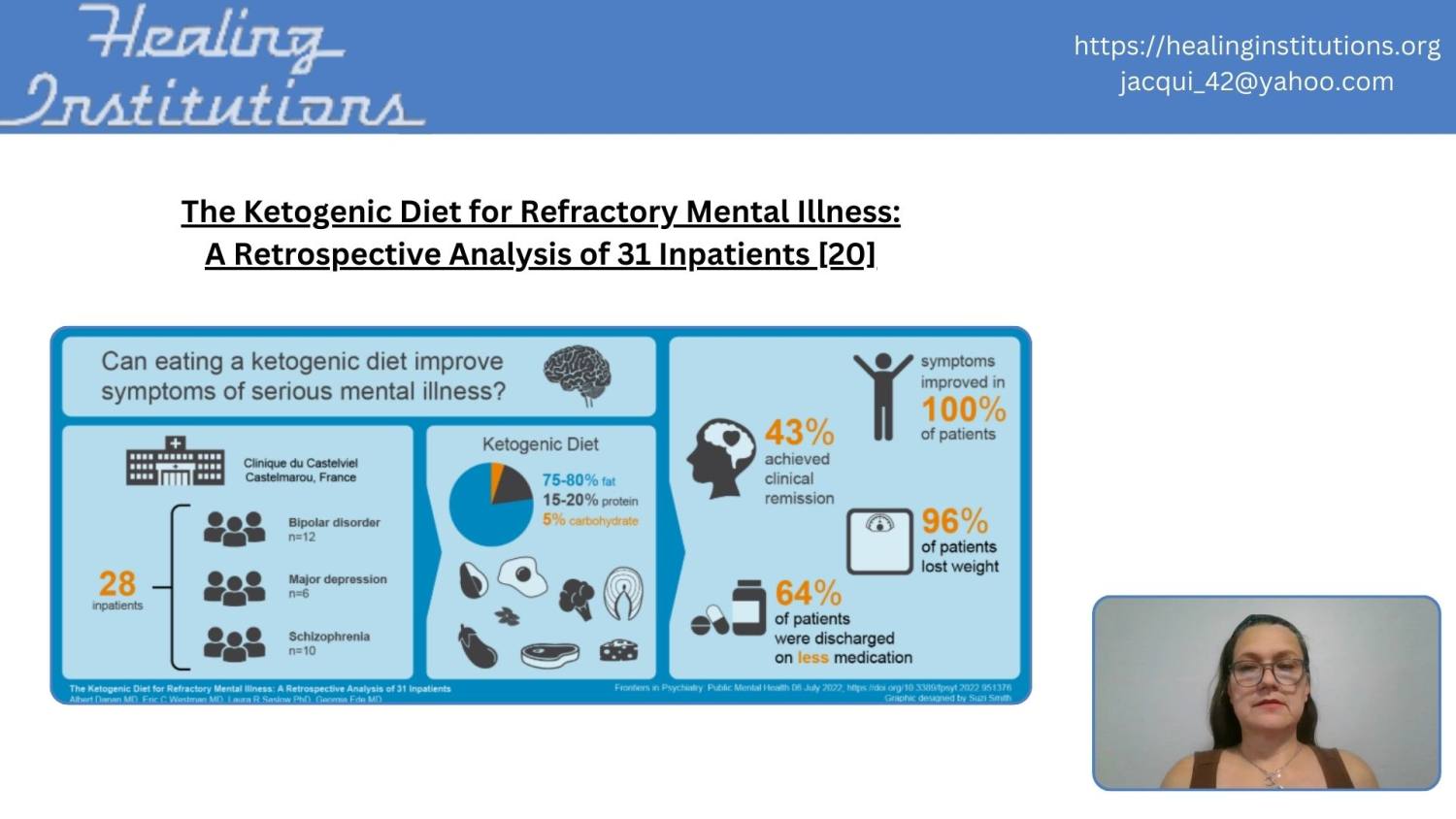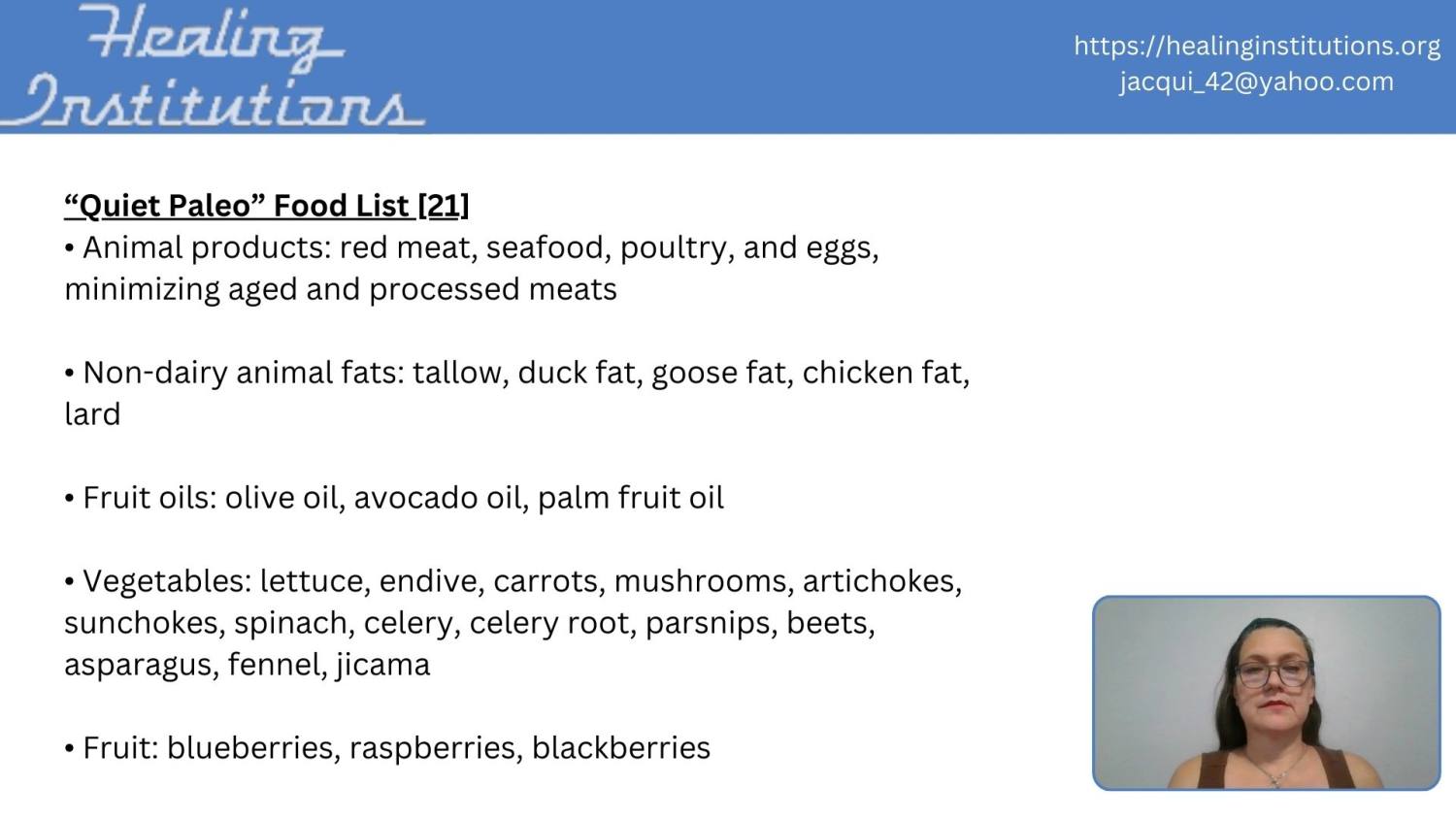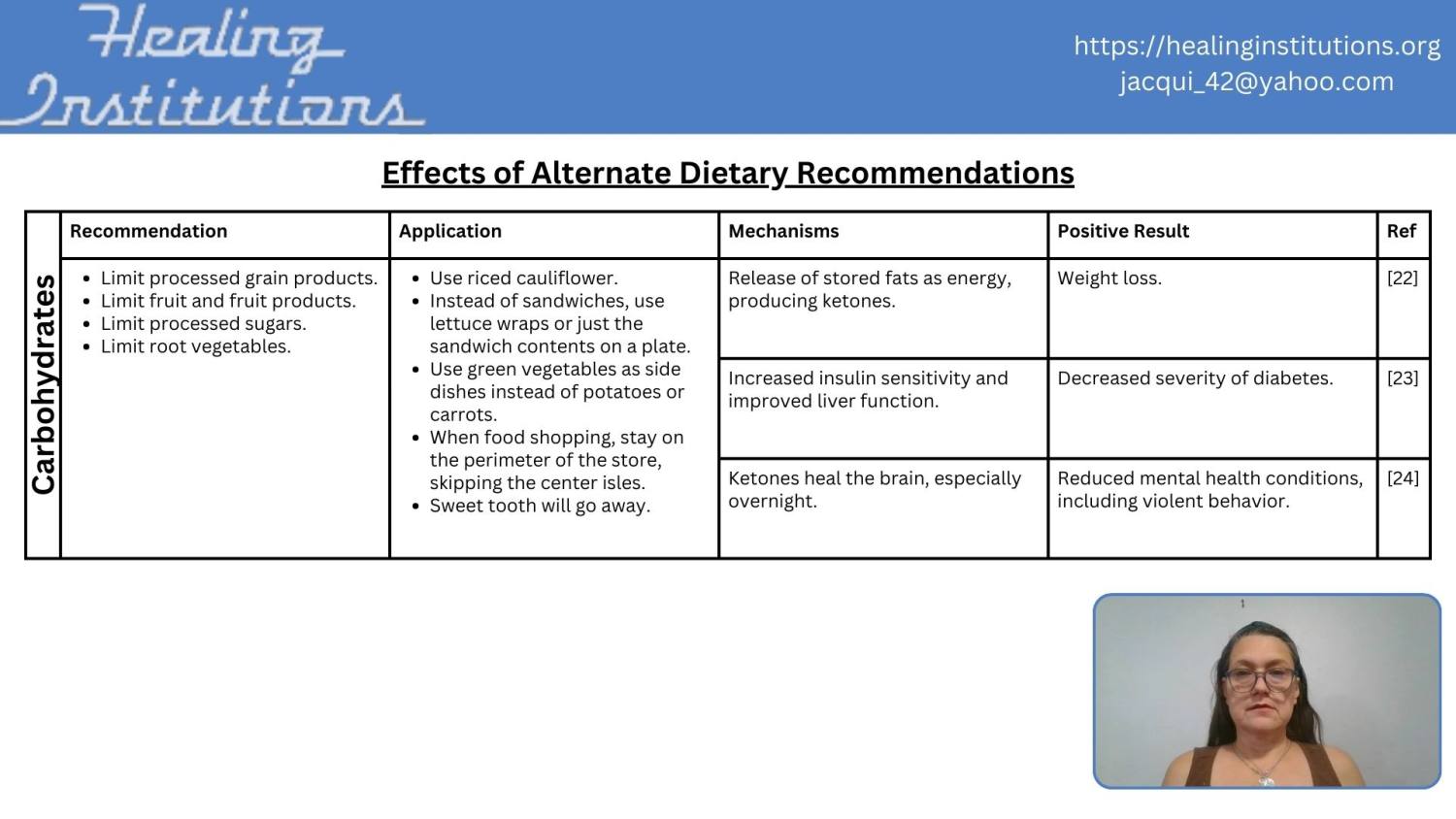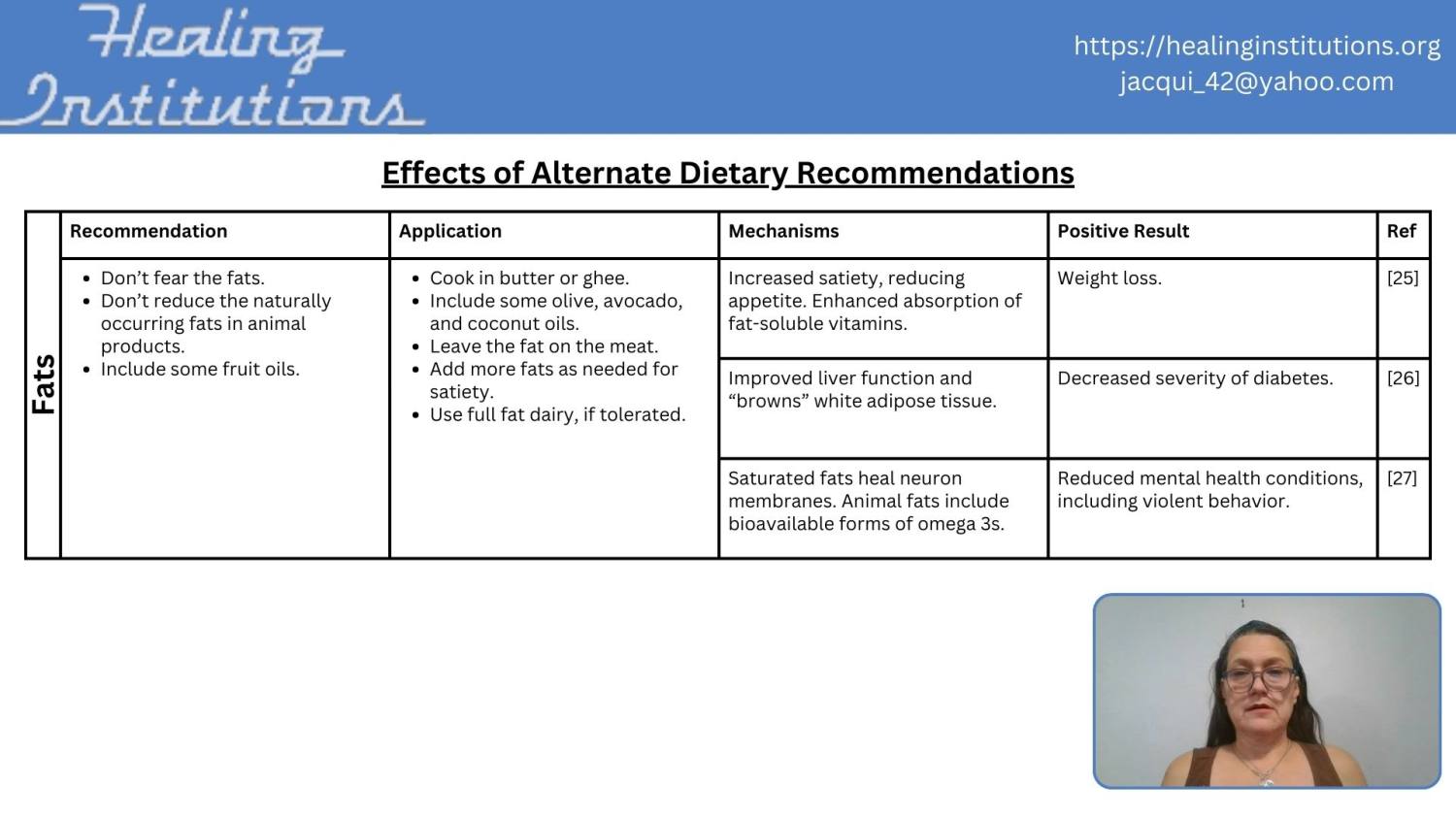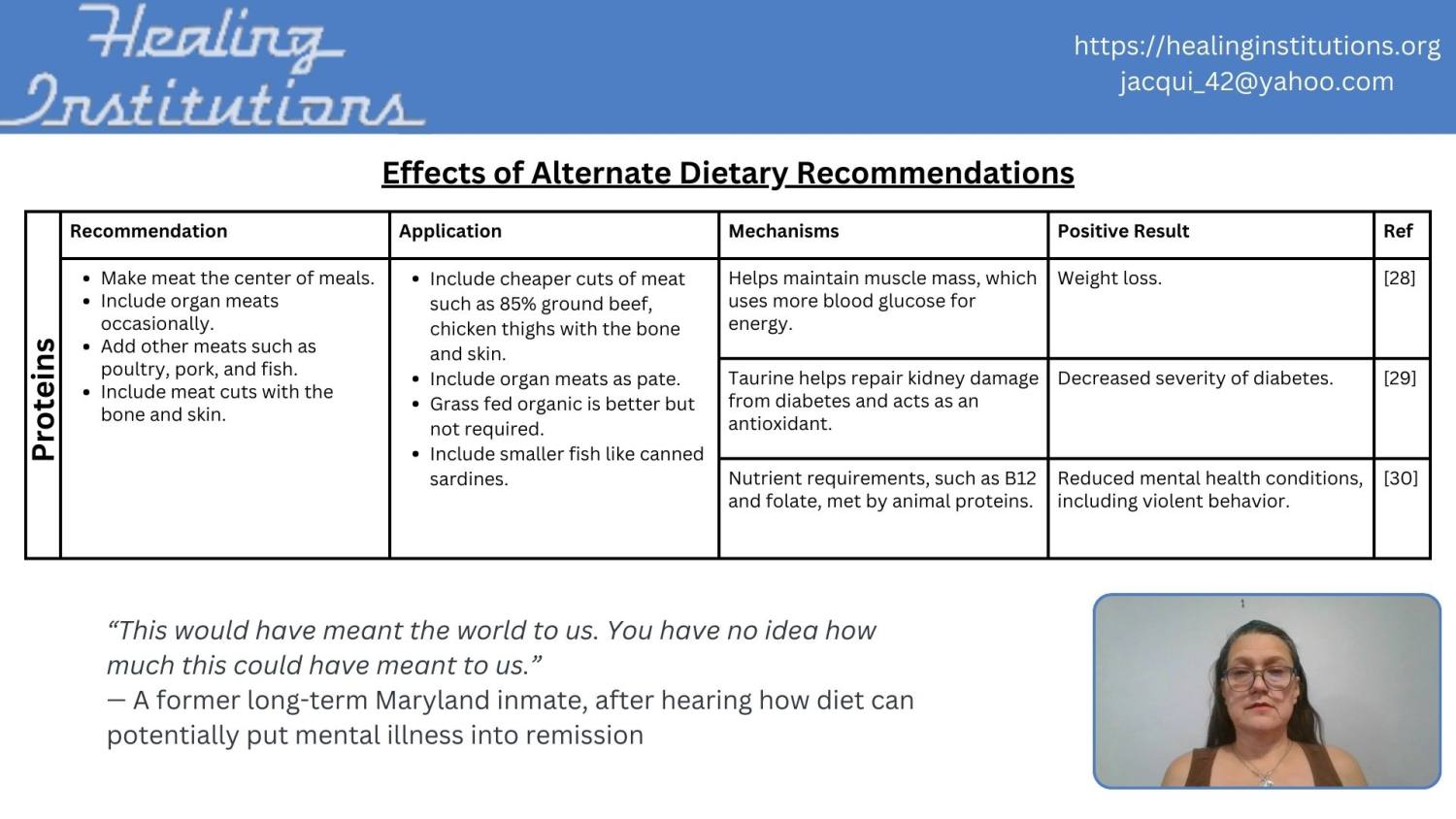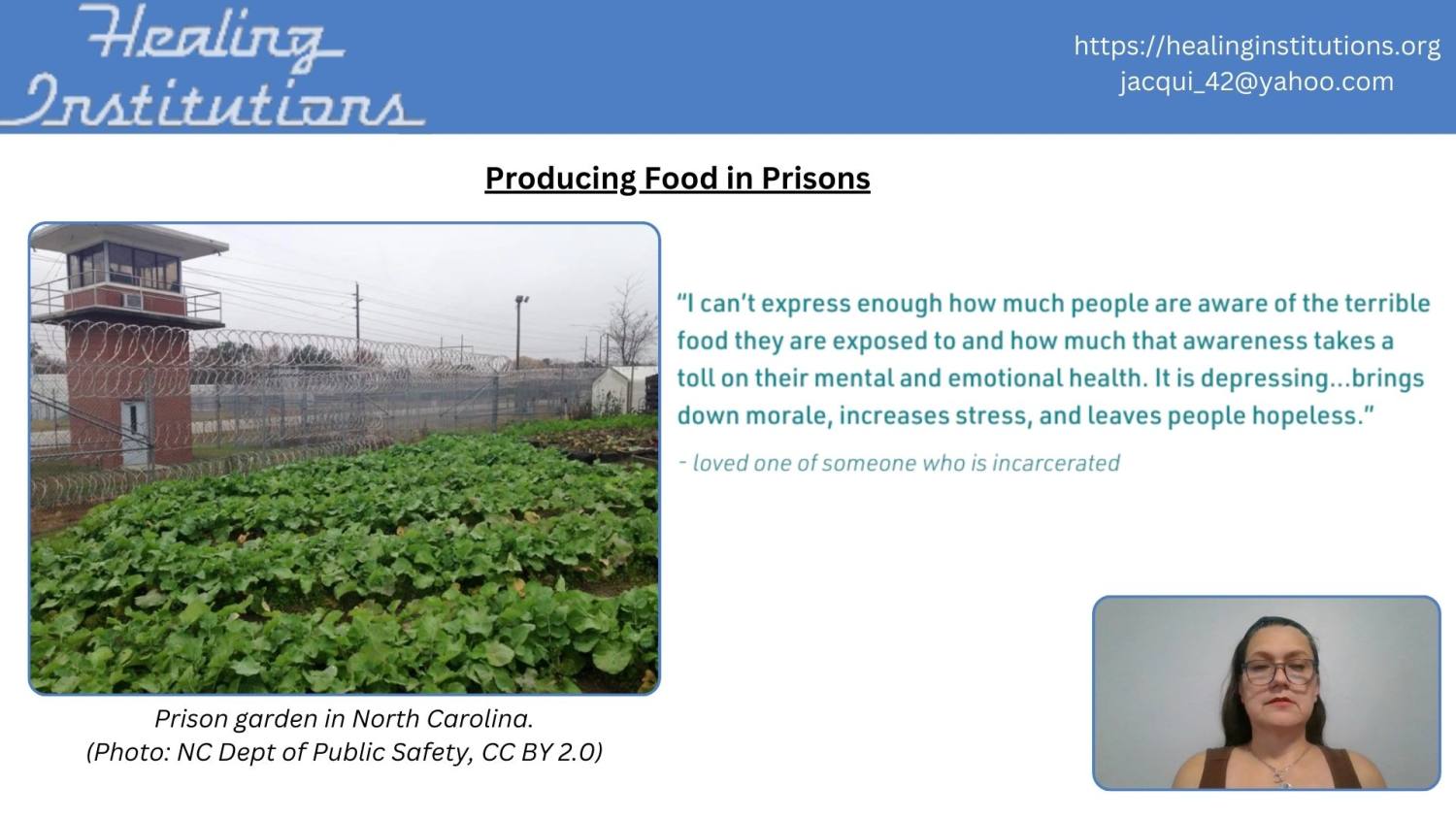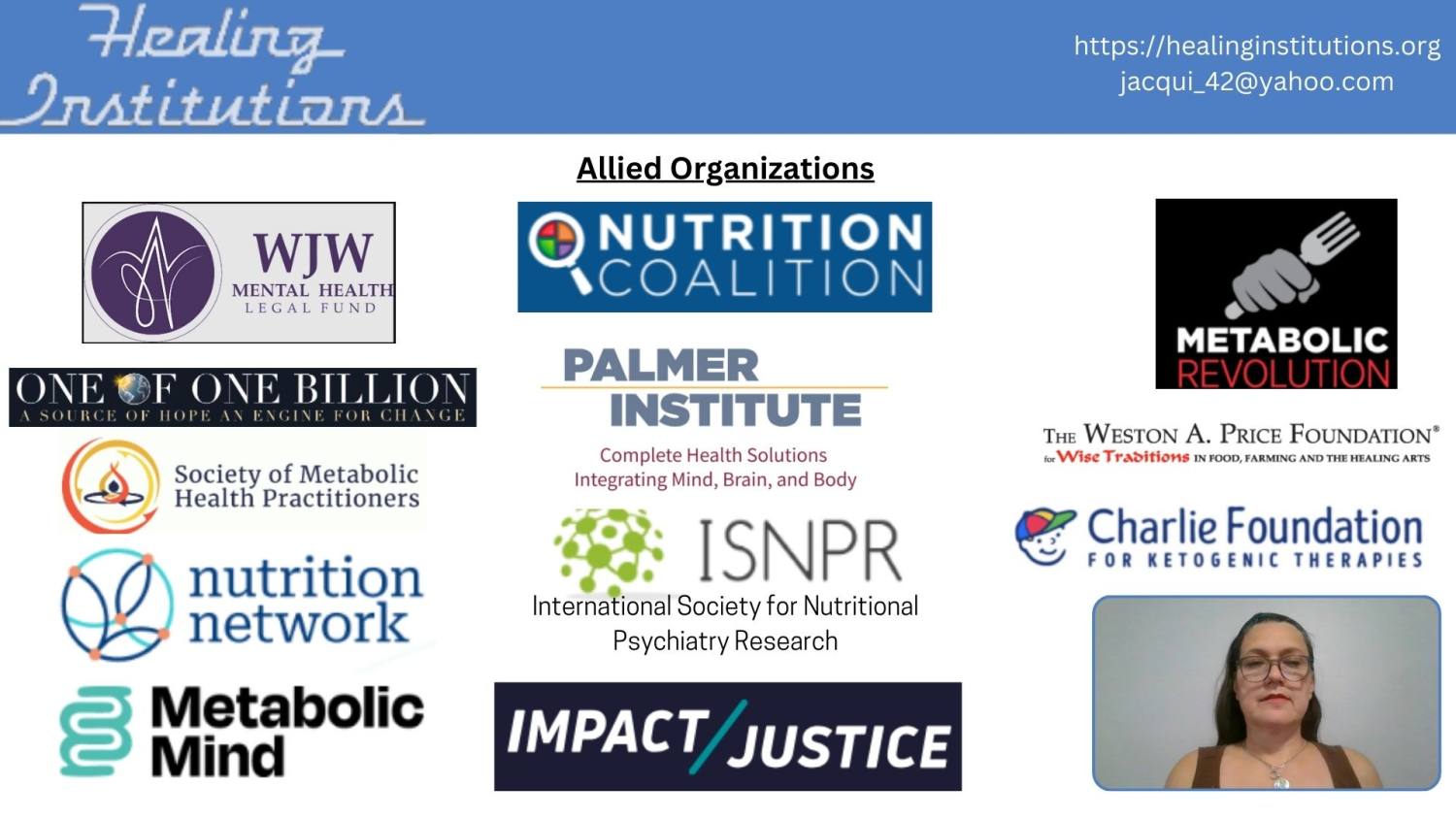USDA Dietary Guidelines
Oral Comments for the 2025 USDA Dietary Guidelines Scientific Committee
"I am Jacquelyn Hossfeld, founder of Healing Institutions. We aim to improve the health of people in correctional institutions through nutrition and other interventions. I will address issues related to the 2025 USDA Dietary Guidelines and this population."
"The noble intent of the Guidelines is to define a healthy diet. However, they undervalue the critical roles of meats and animal fats in human health, while relying heavily on processed grains and vegetable oils, leading to chronic illnesses, such as obesity, diabetes, and mental health conditions. At least 25% of people in the US now have multiple chronic conditions."
(1) Obesity trends: Fryar, C., Carroll, M., & Afful, J. (2021, February 5). Products - Health E Stats - Prevalence of Overweight, Obesity, and Severe Obesity Among Children and Adolescents Aged 2–19 Years: United States, 1963–1965 Through 2017–2018. Www.cdc.gov. https://www.cdc.gov/nchs/data/hestat/obesity-child-17-18/obesity-child.htm
(2), (3), (5), (6), (8) Food group consumption: USDA. (2024, August 21). USDA ERS - Food Consumption and Nutrient Intakes. Www.ers.usda.gov. https://www.ers.usda.gov/Data/FoodConsumption
(4) Mental health trends: Vahratian, A., Terlizzi, E., Villarroel, M., Zablotsky, B., Blumberg, S., & Webinar, N. (2024). Mental health in the US: New estimates from the national center for health statistics. https://www.cdc.gov/nchs/data/events/nhis-mental-health-webinar-2020-508.pdf
(7) Diabetes trends: Centers for Disease Control and Prevention. (2024, May 15). National Diabetes Statistics Report. CDC. https://www.cdc.gov/diabetes/php/data-research/index.html
(9) Spoken statement that 25% of people in the US have multiple chronic diseases: Boersma, P., Black, L. I., & Ward, B. W. (2020). Prevalence of Multiple Chronic Conditions Among US Adults, 2018. Preventing Chronic Disease, 17(17). https://doi.org/10.5888/pcd17.200130
"In prisons, where both staff and inmates have no other food options, chronic illnesses are 13% more prevalent than in general society."
(10) Spoken statement that chronic disease is 13% higher in prisons: Maruschak, L., & Unangst, J. (2015). Medical Problems of State and Federal Prisoners and Jail Inmates, 2011–12. In U.S. Department of Justice, Office of Justice Programs, Bureau of Justice Statistics. https://bjs.ojp.gov/content/pub/pdf/mpsfpji1112.pdf
(10) Health care in prisons: Lupton Lupez, E., Woolhandler, S., Himmelstein, D. U., Hawks, L., Dickman, S., Gaffney, A., Bor, D., Schrier, E., Cai, C., Azaroff, L. S., & McCormick, D. (2024). Health, access to care, and financial barriers to care among people incarcerated in US prisons. JAMA Internal Medicine. https://doi.org/10.1001/jamainternmed.2024.3567
(11) Carbohydrates and obesity: Ludwig, D. S., Aronne, L. J., Astrup, A., de Cabo, R., Cantley, L. C., Friedman, M. I., Heymsfield, S. B., Johnson, J. D., King, J. C., Krauss, R. M., Lieberman, D. E., Taubes, G., Volek, J. S., Westman, E. C., Willett, W. C., Yancy, W. S., & Ebbeling, C. B. (2021). The carbohydrate-insulin model: a physiological perspective on the obesity pandemic. The American Journal of Clinical Nutrition. https://doi.org/10.1093/ajcn/nqab270
(12) Carbohydrates and diabetes: Basu, S., Yoffe, P., Hills, N., & Lustig, R. H. (2013). The Relationship of Sugar to Population-Level Diabetes Prevalence: An Econometric Analysis of Repeated Cross-Sectional Data. PLoS ONE, 8(2), e57873. https://doi.org/10.1371/journal.pone.0057873
(13) Carbohydrates and mental health: Borovcanin, M. M., Vesic, K., Petrovic, I., Jovanovic, I. P., & Mijailovic, N. R. (2023). Diabetes mellitus type 2 as an underlying, comorbid or consequent state of mental disorders. World J Diabetes, 14(5), 481–493. https://doi.org/10.4239/wjd.v14.i5.481
"This increases health care costs, unresolved health conditions, violent behavior, and hinders readiness for reintegration into society."
(14) Vegetable oils and obesity: Naughton, S. S., Mathai, M. L., Hryciw, D. H., & McAinch, A. J. (2016). Linoleic acid and the pathogenesis of obesity. Prostaglandins & Other Lipid Mediators, 125, 90–99. https://doi.org/10.1016/j.prostaglandins.2016.06.003
(15) Vegetable oils and diabetes: Mariamenatu, A. H., & Abdu, E. M. (2021). Overconsumption of Omega-6 Polyunsaturated Fatty Acids (PUFAs) versus Deficiency of Omega-3 PUFAs in Modern-Day Diets: The Disturbing Factor for Their "Balanced Antagonistic Metabolic Functions" in the Human Body. Journal of Lipids, 2021(1), 1–15. https://doi.org/10.1155/2021/8848161
(16) Vegetable oils and violent behavior: Golomb, B. A., Stattin, H., & Mednick, S. (2000). Low cholesterol and violent crime. Journal of Psychiatric Research, 34(4-5), 301–309. https://doi.org/10.1016/s0022-3956(00)00024-8
"After release, a lack of adequate nutrition can inhibit rational decision making processes, leading to higher recidivism rates."
(17) Plant proteins and obesity: Yves Boirie, Pinel, A., & Guillet, C. (2023). Protein and amino acids in obesity: friends or foes? Current Opinion in Clinical Nutrition & Metabolic Care, 26(6), 508–513. https://doi.org/10.1097/mco.0000000000000978
(18) Plant proteins and diabetes: Tettamanzi, F., Bagnardi, V., Louca, P., Nogal, A., Monti, G. S., Mambrini, S. P., Lucchetti, E., Maestrini, S., Mazza, S., Rodriguez-Mateos, A., Scacchi, M., Valdes, A. M., Invitti, C., & Menni, C. (2021). A High Protein Diet Is More Effective in Improving Insulin Resistance and Glycemic Variability Compared to a Mediterranean Diet—A Cross-Over Controlled Inpatient Dietary Study. Nutrients, 13(12), 4380. https://doi.org/10.3390/nu13124380
(19) Inadequate animal-based foods and violent behavior: Golomb, B. A. (1998). Cholesterol and violence: is there a connection? Annals of Internal Medicine, 128(6), 478–487. https://doi.org/10.7326/0003-4819-128-6-199803150-00009
"Dr. Georgia Ede, a nutritional psychologist, and her colleagues used diet successfully in an inpatient mental health facility to help patients with treatment-resistant mental health conditions. 43% of patients had their conditions go into remission, 64% decreased their required medications, and 96% lost weight."
(20) Diet puts mental illness into remission: Danan, A., Westman, E. C., Saslow, L. R., & Ede, G. (2022). The Ketogenic Diet for Refractory Mental Illness: A Retrospective Analysis of 31 Inpatients. Frontiers in Psychiatry, 13. https://doi.org/10.3389/fpsyt.2022.951376
"Based on that study and others, she developed a diet over 10 years to help her patients. The quiet paleo diet consists of whole foods, such fatty cuts of red meat, fish and poultry, as well as vegetables and low-fructose fruits such as berries, while eliminating high-sugar citric fruits, which can be converted to alcohol in prisons."
(21) Quiet Paleo: Dr. Georgia Ede. (2024). Change Your Diet, Change Your Mind. Balance.
"Potential benefits to inmates, correctional staff, and society at large,..."
(22) Low carbohydrates and weight loss: Unwin, D., Delon, C., Unwin, J., Tobin, S., & Taylor, R. (2023). What predicts drug-free type 2 diabetes remission? Insights from an 8-year general practice service evaluation of a lower carbohydrate diet with weight loss. BMJ Nutrition, Prevention & Health, 6(1), e000544. https://doi.org/10.1136/bmjnph-2022-000544
(23) Low carbohydrates and diabetes remission: ATHINARAYANAN, S. J., VANTIEGHEM, M., MCKENZIE, A. L., HALLBERG, S., ROBERTS, C. G. P., VOLK, B. M., ADAMS, R. N., RATNER, R. E., VOLEK, J., & PHINNEY, S. (2022). 832-P: Five-Year Weight and Glycemic Outcomes following a Very-Low-Carbohydrate Intervention Including Nutritional Ketosis in Patients with Type 2 Diabetes. Diabetes, 71(Supplement_1). https://doi.org/10.2337/db22-832-p
(24) Ketones and lower levels of violence: Bender, E. (2024, April 18). Early Evidence Supports Ketogenic Diet for Mental Illness. Medscape. https://www.medscape.com/viewarticle/early-evidence-supports-ketogenic-diet-mental-illness-2024a10007jc?form=fpf
"... are less violent behavior, lower health care costs, …"
(25) Animal fats and weight loss: Tso, P., & Liu, M. (2004). Ingested fat and satiety. Physiology & Behavior, 81(2), 275–287. https://doi.org/10.1016/j.physbeh.2004.02.024
(26) Animal fats and diabetes: Cao, Y., Araki, M., Nakagawa, Y., Deisen, L., Lundsgaard, A., Kanta, J. M., Holm, S., Johann, K., Brings Jacobsen, J. C., Jähnert, M., Schürmann, A., Kiens, B., Clemmensen, C., Shimano, H., Fritzen, A. M., & Kleinert, M. (2024). Dietary medium-chain fatty acids reduce hepatic fat accumulation via activation of a CREBH-FGF21 axis. Molecular Metabolism, 87, 101991. https://doi.org/10.1016/j.molmet.2024.101991
(27), (30) Animal products and decreased violent behavior: Gesch, C. B., Hammond, S. M., Hampson, S. E., Eves, A., & Crowder, M. J. (2002). Influence of supplementary vitamins, minerals and essential fatty acids on the antisocial behaviour of young adult prisoners. Randomised, placebo-controlled trial. The British Journal of Psychiatry: The Journal of Mental Science, 181(1), 22–28. https://doi.org/10.1192/bjp.181.1.22
"... lower recidivism rates, and safer neighborhoods."
(28) Animal protein and weight loss: Olaniyan, E. T., O’Halloran, F., & McCarthy, A. L. (2020). Dietary Protein Considerations for Muscle Protein Synthesis and Muscle Mass Preservation in Older Adults. Nutrition Research Reviews, 34(1), 1–26. https://doi.org/10.1017/s0954422420000219
(29) Animal proteins and diabetes: Ural, C., Celik, A., Ozbal, S., Guneli, E., Arslan, S., Ergur, B. U., Cavdar, C., Akdogan, G., & Cavdar, Z. (2023). The renoprotective effects of taurine against diabetic nephropathy via the p38 MAPK and TGF-ß/Smad2/3 signaling pathways. Amino Acids, 55(11), 1665–1677. https://doi.org/10.1007/s00726-023-03342-w
(30) Animal products and decreased violent behavior: Gesch, C. B., Hammond, S. M., Hampson, S. E., Eves, A., & Crowder, M. J. (2002). Influence of supplementary vitamins, minerals and essential fatty acids on the antisocial behaviour of young adult prisoners. Randomised, placebo-controlled trial. The British Journal of Psychiatry: The Journal of Mental Science, 181(1), 22–28. https://doi.org/10.1192/bjp.181.1.22
"Because this approach requires whole foods, inmates can at least partially participate in producing the food and preparing meals for their facilities. This enhances opportunities for healing and growth."
(31) Statement about the link between food and prison violence: Haque, A. (2024, November 30). The impact of prison gardens on the rehabilitation of prisoners. Emory Undergraduate Medical Review. https://www.eumr.org/open-access/blog-post-one-y2wga
(32) Statement about the link between food and prison violence: Soble, L., Stroud, K., & Weinstein, M. (2020). Eating Behind Bars: Ending the Hidden Punishment of Food in Prison. Impact Justice. https://impactjustice.org/wp-content/uploads/IJ-Eating-Behind-Bars.pdf
"Healing Institutions is one of many organizations that believe that inmates require an environment that supports growth and rehabilitation, that citizens do not deserve to become victims of crime, and that the first step to these goals is proper nutrition."
"Thank you for your time and consideration."
Transcript & References

